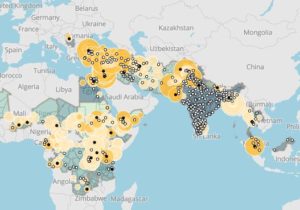Most refugees living in urban areas
 A new analysis and map shows how most of the world’s refugees are living in the urban areas of developing nations and not in refugee camps.
A new analysis and map shows how most of the world’s refugees are living in the urban areas of developing nations and not in refugee camps.
Produced by the Washington-based Center for Global Development (CGD) and the Tent Partnership for Refugees, the analysis shows that as many as 2.1 million refugees of working age (18 to 59) live in major urban areas in developing countries.
The organisations’ report points out that there are substantial employment opportunities for these refugees that would also lower the cost of hosting them and create economic benefits for host countries.
It said that about 60 per cent of all refugees live in urban areas not desolate camps.
The researchers aimed to find out if refugees of working age were living close enough to cities to take advantage of the work opportunities there with multinational, regional and local businesses.
So, they mapped where refugees live in 31 of the 37 developing countries that host more than 25,000 refugees.
They found that 38 percent of all working-age refugees in developing countries live in major urban areas. They estimate that’s anywhere from 915,000 to nearly 2.2 million refugees. In five to seven of the countries analyzed, there are more than 50,000 refugees in major cities.
The map they produced also shows that many of the countries that have the most people hired by multinational corporations also have the largest clusters of working-age refugees living in urban areas.
The world is facing unprecedented levels of displacement due to conflicts, prolonged instability and humanitarian crises. According to the UN refugee agency, there are now more than 25 million refugees around the world in need of sustainable solutions, and about 85 percent of them are being hosted by low- and middle-income countries.
“As market leaders with global reach through hiring and supply chains, policy influencers, and innovators, multinational corporations have distinctive capacities for engagement that do not exist within the traditional refugee response community,” the report said.
“There are many barriers to employing refugees but companies should know that geography isn’t one of them, Our advice to multinational companies is hire refugees if they can,” Cindy Huang, the lead author of the study and co-director of migration, displacement, and humanitarian policy at the Center for Global Development said in a press release.
But the report notes that other major barriers may still preclude businesses from working with refugees. These include discrimination, restrictions on movement in a country and laws that prohibit refugees from working or owning businesses.
“There’s a real economic opportunity here, but only if policymakers reduce these barriers to employment and support new opportunities for refugees and host communities,” Ms Huang said.
The world is facing unprecedented levels of displacement due to conflicts, prolonged instability and humanitarian crises. According to the UN refugee agency, there are now more than 25 million refugees around the world in need of sustainable solutions, and about 85 percent of them are being hosted by low- and middle-income countries.
One proposed approach is to expand economic opportunities for refugees in developing countries, which host 85 percent of the world’s refugees.
In recent years, governments, donors, and private sector actors have been finding innovative ways to include refugees in labor markets, thus enabling them to become more self-reliant, reducing the cost of hosting refugees and creating economic benefits for hosts.
The report said Multinational corporations (MNCs) are emerging as important partners in the push to expand refugee employment and entrepreneurship. As market leaders with global reach through hiring and supply chains, policy influencers, and innovators, MNCs have distinctive capacities for engagement that do not exist within the traditional refugee response community.
To help demonstrate where MNCs, regional and local businesses, and other actors could expand economic opportunities for refugees, the researchers created an interactive tool to map the locations of refugees, and analysed the extent to which refugees overlap with major urban areas in 31 of the 37 developing countries hosting at least 25,000 refugees.
When refugees are located in urban areas, where economic activity and MNCs cluster, they have a much greater likelihood of being in close proximity to potential employers.
Using estimates of refugîs living in countries’ most populous cities and those living in cities with over 300,000 people as lower and upper bounds for the number of refugees in or around major urban areas, the researchers found that of the 31 countries: 15 to 17 have at least 7,000 working-age refugees in or around major urban areas; 9 to 11 have at least 25,000 working-age refugees in or around major urban areas, and; 5 to 7 have at least 50,000 working-age refugees in or around major urban areas.
“In total we estimate that there are between 915,087 and 2,186,829 working-age refugees in or around major urban areas in these countries,” the report said.
See the full report and interactive map here: https://www.cgdev.org/publication/are-refugees-located-near-urban-job-opportunities
Laurie Nowell
AMES Australia Senior Journalist












